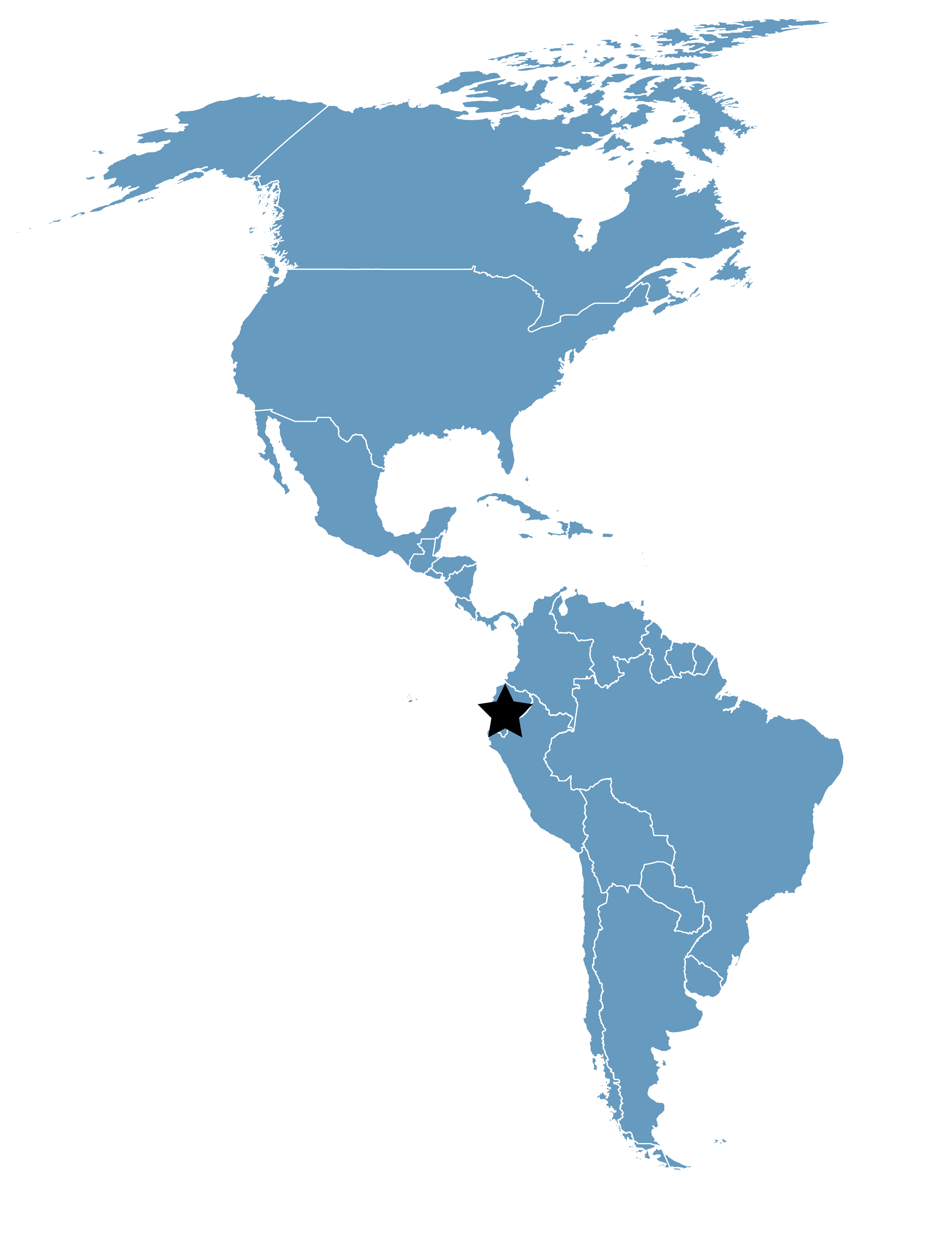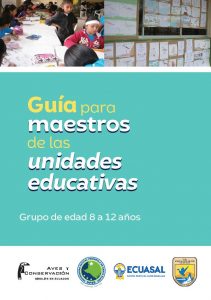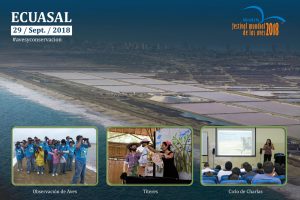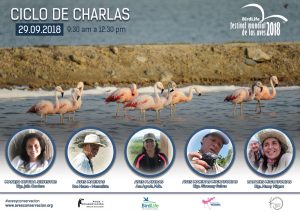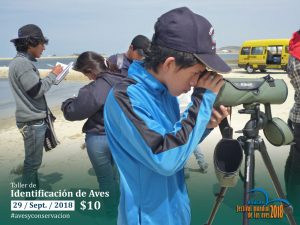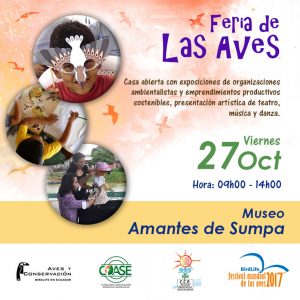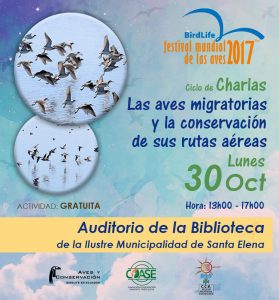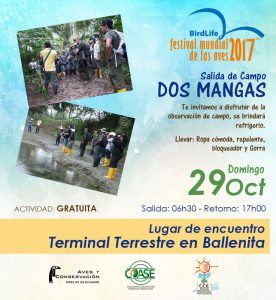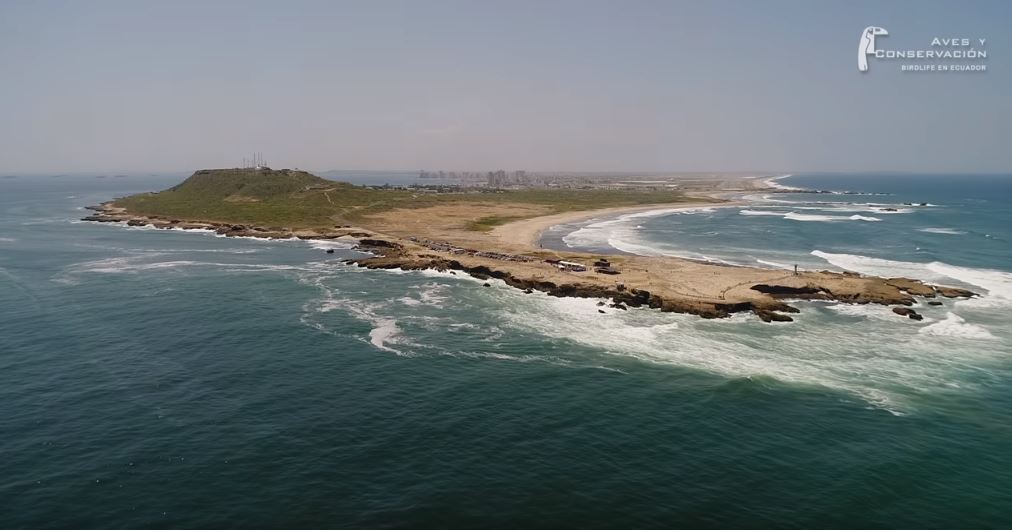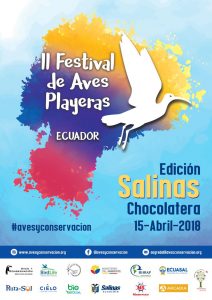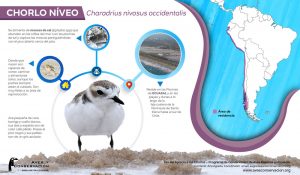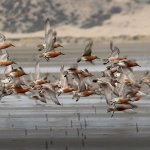Piscinas Artificiales de ECUASAL
Location
Province of Santa Elena, Ecuador
Category
Regional
Basis for Designation
More than 20,000 shorebirds per year.
Size
1,300 hectares (3,212 acres)
Date Designated
January 2007
Site Owner
Ecuatoriana de Sal y Productos Químicos C.A. (ECUASAL)
Site Partners
Aves & Conservación Museum of Whales in Salinas
State University of the Península of Santa Elena (UPSE)
Overview
ECUASAL artificial salt lakes were man-made in the 1960s to produce salt for both industry and human consumption. Around 70% of the salt used in Ecuador comes from the ECUASAL salt lakes. Salt is obtained by evaporation of seawater that circulates within a complex of large evaporation ponds (> 40 ha) to reach the appropriate density for crystallization. The salt lakes are an artificial ecosystem where biotic communities of microinvertebrates outcrop in a hypersaline gradient (Agreda 2012). The salt lakes are located along a long white sand beach called “Mar Bravo,” named for its heavy swell.
More than 100,000 aquatic birds, including migratory and resident species, arrive to ECUASAL every year.
23 species of shorebirds have been recorded at ECUASAL. The 10 most common species are: Tringa melanoleuca (Greater Yellowlegs), T. flavipes (Lesser Yellowlegs), T. semipalmata (Willet), Arenaria interpres (Ruddy Turnstone), Calidris alba (Sanderling), C. pusilla (Semipalmated Sandpiper), C. minutilla (Least Sandpiper), C. himantopus (Stilt Sandpiper), Limnodromus griseus (Short-billed Dowitcher) and Phalaropus tricolor (Wilson´s Phalarope).
Thousands of Wilson’s Phalaropes gather at ECUASAL salt lakes between August and October every year. The salt lakes cover an area of 1,300 hectares and are the largest artificial wetlands in Ecuador. The maximum Wilson Phalarope count in one year has been 59,500 individuals, which represents around 5% of this species’ global population (estimated at 1,500,000 individuals). These are the highest numbers ever recorded for one migratory species in Ecuador. A study of Wilson’s Phalarope chronology and microhabitat use in 2008 demonstrated that this species stayed at ECUASAL from 15 days to one month, and preferred the evaporation ponds of high salinity, which represent around 25% of the effective area of the wetlands. Phalaropes feed voraciously on larvae and adults of Artemia salina (Brine Shrimp) and Ephydra spp. (Brine Fly) (Agreda et al. 2009).
These bird species use the salt lakes as a refuge, wintering or stopover site. ECUASAL also provides important habitat for the near-threatened Chilean Flamingo (Phoenicopterus chilensis), Peruvian Pelican (Pelecanus thagus), Elegant Tern (Thalasseus elegans), and the endangered Peruvian Tern (Sternula lorata).
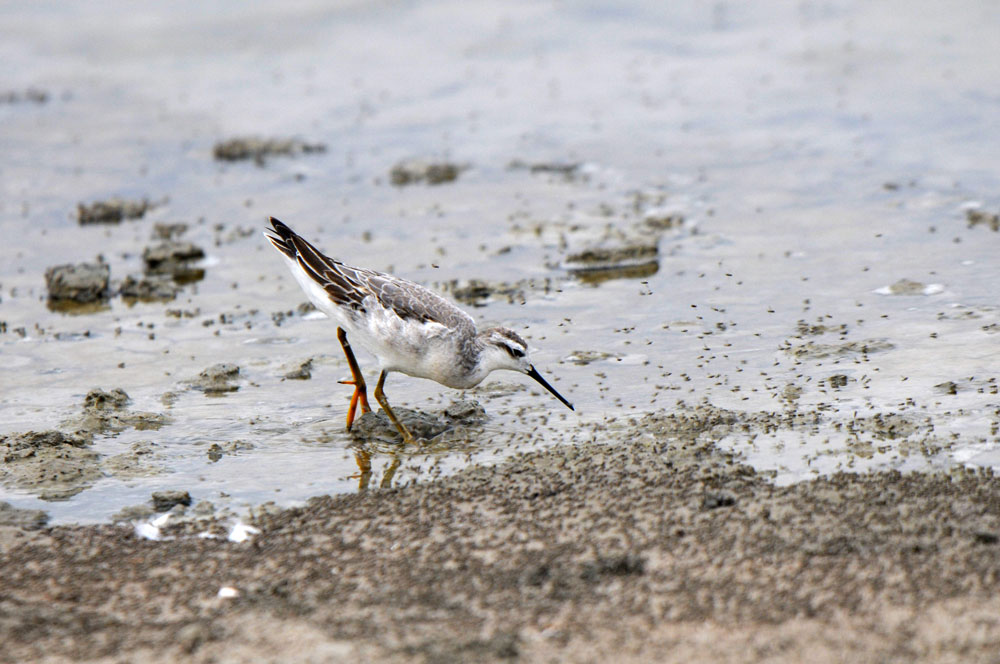
Wilson’s Phalarope feeding on brine flies at Pacoa, Monteverde. Photo: Ana Agreda.
Threats
The main threats at ECUASAL salt lakes are:
- Habitat degradation due to urban and industrial development
- Expansion or intensification of aquaculture practices
- Oil exploitation
- Artisanal salt production
- Invasive species
- Human disturbance
- Environmental contamination
Habitat degradation in the areas surrounding the salt production plants has increased during the last decade. In Mar Bravo, Salinas, there are dense urban settlements, some of which are illegal and unregulated. In Pacoa, Monteverde, human settlements are more distant, and the area still has a spiny scrubland vegetative cover.
Another threat is the intensification of aquaculture practices, more specifically development of laboratories for shrimp larva production in the area surrounding the salt lakes. The aquaculture industry in Santa Elena province is developing right along the coast line, as the primary resource for larva production is sea water. The laboratories pump sea water on a daily basis in order to later sterilize and fertilize it for mass production of shrimp larvae of Litopenaeus vannamei (White Shrimp).
Oil exploitation is another threat. In both production plants there are active wells close to the perimeter of the pools and within the pools themselves. There are also unexploited wells that were accidentally opened by salt producers and construction companies that caused the formation of large surface oil slicks between 2010 and 2012. These problems have been mitigated by the companies responsible for exploiting Ecuadorian oil in recent years (2012 – 2013).
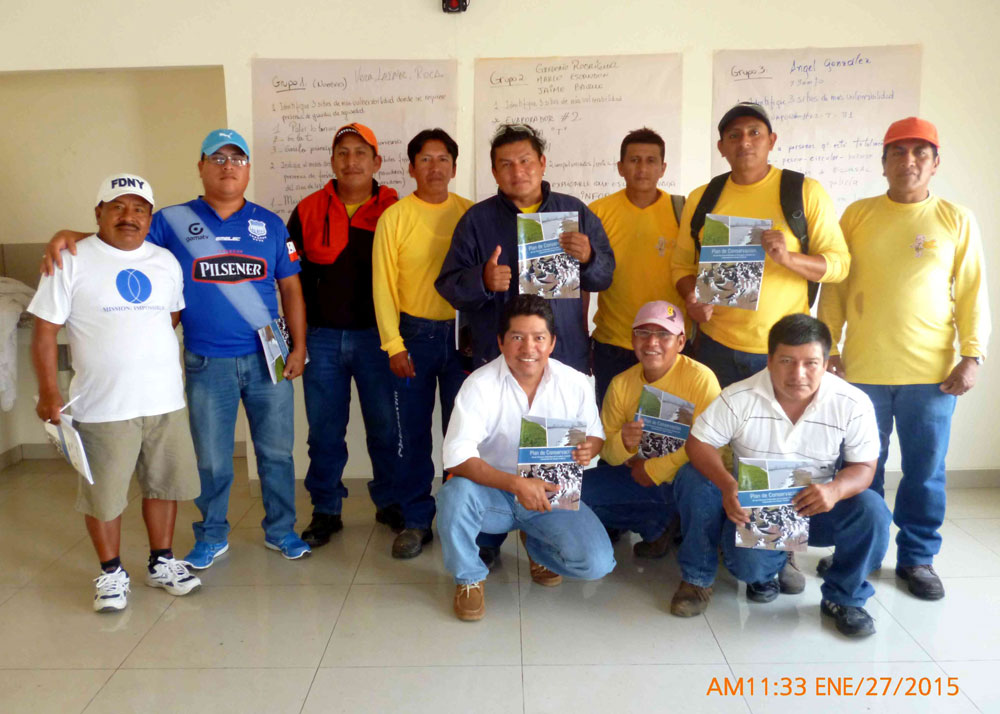
Surveillance Implementation Workshop for security guards of the ECUASAL Company. Photo: Aves y Conservación.
Artisanal salt production has been an important economic activity in the province of Sta. Elena, and more specifically in the county of Salinas since the beginning of the 19th century. Nowadays, artisanal salt producers are organized into legal associations in order to lease state land to create their ponds, though some artisans are not legally incorporated and occupy state and private land. Artisanal salt production is not regulated by the Ecuadorian government, the lack of an environmental licensing or/and the lack of a land use plan for the area surrounding the salt lakes has led artisanal salt production to become an informal activity.
Among the biggest direct human pressures on the salt lakes is trespassing by cyclists, runners, and bathers that use the discharge water channel for recreation purposes (Agreda 2014). It is possible that this type of disturbance produces a negative impact on the resident aquatic wildlife that nest in the ECUASAL salt lakes. Studies on reproductive success of Charadrius nivosus occidentalis (Snowy Plover) in Mar Bravo demonstrated that half of the nests found during a breeding season failed due to the presence of dogs and people coming into close contact with the nests (Borbor 2015). ECUASAL personnel now conduct a patrolling and surveillance program that has greatly helped to control this problem (Agreda obs. Pers.).
Pollution from inorganic waste, plastics and domestic garbage is also a threat in the rainwater canals, their surroundings, and even on the beaches. This type of inorganic waste (all types of plastics) comes from the poor handling of solid waste from the shrimp larvae production industry, combined with the lack of a comprehensive integrated waste management plan in the country.
Habitat Protection and Conservation Efforts
Aves y Conservación / BirdLife in Ecuador has been working since late 2007 on the project, “Conserving priority areas for aquatic migratory bird fauna in the Peninsula of Sta. Elena, Salt Lakes of ECUASAL”. The goal of this project is “Work for the conservation of migratory and resident aquatic birdfauna of ECUASAL and the Peninsula of Santa Elena, and promote this work as a model that reconciles production and conservation”. The project has three major strategic lines of action: 1. Environmental awareness and education directed to local populations, 2. Research and bird population monitoring and 3. Environmental management to reduce threats to migratory and resident wildlife populations.
We have made great efforts to link government organizations with the project. Among the most important partnerships are the agreement between Aves y Conservación and the National University of Santa Elena (UPSE), and with the Village Council of José Luis Tamayo (Muey). The project also established partnerships with the Municipality of Salinas, Municipality of Sta. Elena, Provincial Prefecture of Santa Elena and with the provincial directorate of the Ministry of Environment. All are partners that support the environmental management of the ECUASAL salt lakes.
In 2010, Aves y Conservación completed the Conservation Plan for the Artificial Salt Lakes of ECUASAL for the period 2012 – 2015, and the ECUASAL company has been implementing the programs and subprograms of work identified in the Plan. The main results are the implementation of a Surveillance Program to monitor the boundaries of the salt production plants, conducting training workshops for security personnel of ECUASAL on the best environmental management practices and awareness of environmental problems involving bird populations. Additionally we developed several patrolling protocols, with support from Ecuasal’s technical staff, to reduce human disturbance at the site. This effort has allowed us to recognize areas and timing of greater vulnerability and major problems occurring at the limits. The project also included the design and installation of educational WHSRN signs and the construction and maintenance of guardhouses and entrance kiosks at the boundaries of the site.
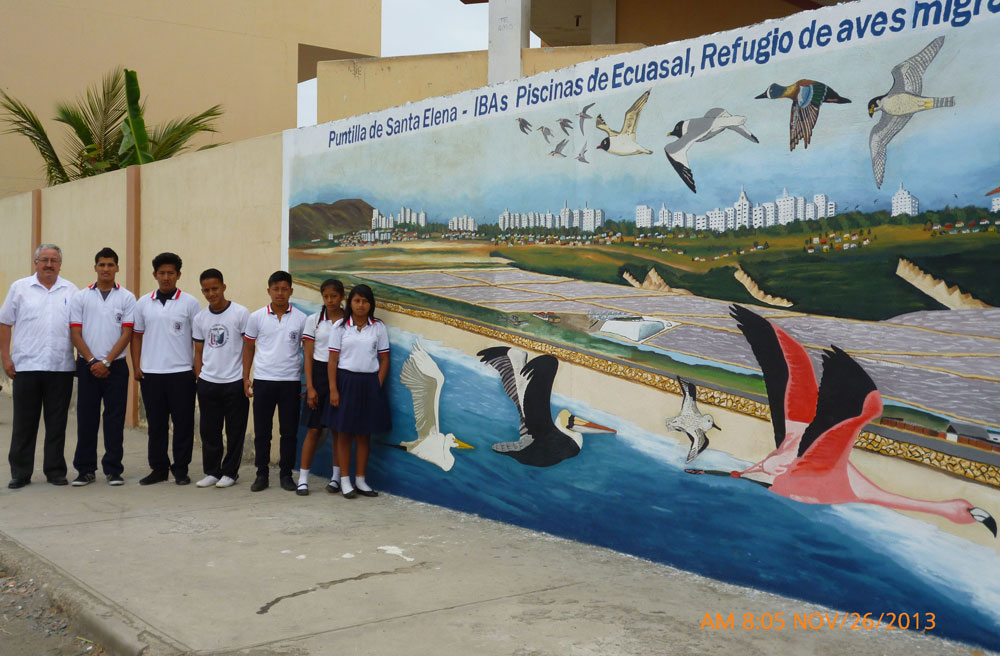
Mural created by high school students during World Bird Festival. Photo: Aves y Conservación.
A major activity carried out in 2013 and 2014 was to work with owners and administrators of shrimp larvae laboratories. We promoted law enforcement to secure environmental licenses and the implementation of best practices management plans needed to regulate the shrimp larvae production. With this goal in mind we carried out working meetings, workshops, and campaigns to reduce solid waste pollution.
Between 2007 and 2014, the Conservation Plan’s Awareness and Environmental Education Program reached more than 5000 people from Santa Elena province. During the early phase (2007-2008) 415 children from 6 schools received educational talks in their classrooms and went on field trips to the ECUASAL Salt Lakes. During the second phase (2010-2011) we worked with 27 schools from Salinas, Muey and San Pablo and 3,100 children received educational talks and visited ECUASAL. In 2012-2014 we worked with 29 schools and high schools from Salinas and Muey, and around 5000 children received educational talks and almost 1000 students visited the salt lakes. Each year we celebrate the World Bird Festival and coordinate outdoor art events that include music, theater, and various contests. More than 500 children attended the October 2013 event.
Research and Monitoring
Since 2010, we have implemented the Research and Monitoring Program as defined in the Conservation Plan. The project runs an internship and scholarship program for university students that want to earn their bachelor degree in Marine Sciences at the National University of Santa Elena. Interns are trained in bird identification techniques and help monitor aquatic bird populations monthly and biweekly.
Research has been carried out on the reproductive success of Charadrius nivosus occidentalis (Snowy Plover), nesting success of sea birds in a mixed colony, chronology and microhabitat use of the Wilson´s Phalarope, and characterization of mixed species flocks of seabirds along the coastline of Santa Elena peninsula. Additionally, the program trains students studying ornithology, and certified naturalist guides from the province of Sta. Elena in birdwatching and bird banding techniques.
Resources
This teacher guide was developed as part of the Environmental Education Program “Ecuasal and Migratory Birds go to Schools.” This guide is for teachers working with students ages 8-12.
WATCH: The 2nd Ecuador Shorebirds Festival. On April 15, 2018 scientists, conservationists, artists and the general public gathered to celebrate the value of birds in La Chocolatera, in the Puntilla de Santa Elena Coastal Marine Reserve on the Ecuadorian coast. The Festival made it fun to learn what shorebirds are, why they come to our province, and why their conservation is important.
This infographic shows how Snowy Plovers (Charadrius nivosus occidentalis) use the Piscinas Artificiales de Ecusal site. Infographic made by the Shorebird Conservation Program of Aves y Conservación / BirdLife in Ecuador, for Plover Appreciation Day.




